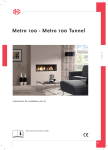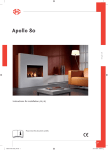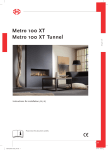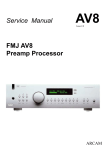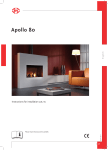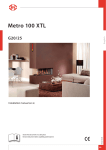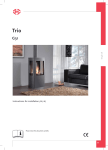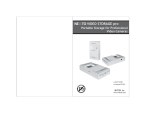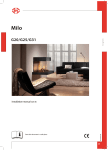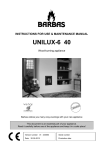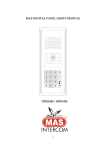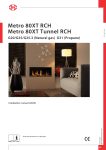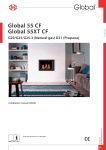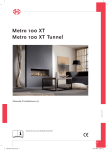Download Largo - Largo Tunnel
Transcript
English Largo - Largo Tunnel Instructions for installation (GB / IE) Please retain this document carefully 1 UK LARGO - I N S T R U C T I O N F O R I N S TA L L AT I O N Contents English Foreword 1. Introduction 2. EC Declaration of Conformity 3. SAFETY 3.1 General 3.2 Regulations 3.3 Precautionary measures / safety instructions regarding installation 4. Instructions 5. Unpacking 6. Installation 6.1 Regulations 6.2 Gas type 6.3 Gas connection 6.4 Positioning the appliance 6.5 Flue gas discharge / combustion air supply system 6.6 Building the chimney breast 6.7 Installing the control box 6.8 Adjusting the appliance 6.9 Arranging the logs 6.10 Glass window 7. Wireless remote control 7.1 Receiver 8. Final inspection 8.1 Gastightness 8.2 Gas pressure/pre-pressure 8.3 Igniting the pilot and main burner 8.4 Flame effect 9. Maintenance 10. Completion 11. Troubleshooting Annex 1 Annex 2 Annex 3 Components supplied Technical data Spare parts page 2 3 3 3 3 3 3 4 4 4 4 4 4 5 6 9 10 10 13 14 16 16 17 17 17 17 18 18 18 19 21 21 21 Foreword As manufacturer of gas heating appliances, DRU develops and produces products to meet the highest possible quality, performance and safety requirements. As a result of which the user is able to enjoy using your appliance for years to come. This appliance is CE marked; it complies with the essential requirements of the European Appliance Directive. The appliance is supplied with two manuals: the installation manual and the user manual. You the installer should be professionally skilled in the field of decorative gas heating. The installation manual gives you all the information you will need to be able to install the appliance in such a way that it works correctly and safely. This manual deals with the installation of the appliance and the appropriate regulations. It also includes the technical data for the appliance and information on maintenance and troubleshooting. Please read and use this installation manual carefully. In the manuals the following symbols are used to denote important information: ➠ !Tip !N.B. N.B. What to do Suggestions and recommendations These instructions are important to avoid possible problems during installation and/or use. These instructions are important to avoid fire, personal injury or other serious damage. Once you have completed the installation you are to hand both the user manual and d this installation manual to the user. UK 2 LARGO - 1. I N S T R U C T I O N F O R I N S TA L L AT I O N Introduction The appliance is available in two models, the Largo and the Largo Tunnel. The Largo is a ‘standard’ gas fire and should always be installed against a wall. The Largo Tunnel is just that, a ‘tunnel fire’ with both a front and back window. The Largo and the Largo Tunnel are closed decorative fires. A closed tunnel draws its combustion air from outside and not from the living area. This is done by way of a combined system that discharges the flue gases and supplies the combustion air. In this concentric system the outer pipe serves as air supply and the inner pipe as the flue. This system can be installed through either the outer wall or the roof. The appliances are built into a chimney breast. The DRU product range includes several chimney breasts. The chimney breast must be well ventilated to ensure a good heat distribution. DRU can supply various ventilation elements. The appliances are supplied with a wireless, battery-operated remote control. 2. EC Declaration of Conformity English We hereby declare that the design and construction of the decorative gas heating appliance marketed by DRU conforms with the essential requirements of the Gas Appliance Directive. This declaration will be rendered invalid should the appliance be altered in any way without the written consent of DRU. Product: Decorative gas heating appliance Type: Largo Largo Tunnel Applicable EC Directives: 90/396/EEC Applicable harmonised standards: NEN-EN-613, NEN-EN-613/A1 In-house measures guarantee that serially produced appliances always conform with the essential requirements of the current EC Directives and the applicable standards. R. Gelten DRU VERWARMING B.V. Postbus 1021, 6920 BA Duiven Ratio 8, 6921 RW Duiven www.dru.nl 3. SAFETY 3.1 General N.B. - Please read this chapter on safety carefully before commencing installation or maintenance; - Always observe universal regulations and the precautionary measures / safety instructions in this manual. 3.2 Regulations The appliance should be installed in compliance with current national, local and constructional (installation) regulations. 3.3 Precautionary measures / safety instructions regarding installation Observe the following precautions / safety regulations precisely: ➠ ➠ ➠ ➠ ➠ ➠ ➠ ➠ ➠ ➠ ➠ ➠ ➠ ➠ ➠ You may only install and/or service this appliance if your are a qualified installer skilled in installing decorative gas fires; do not adjust the appliance in any way; Non-combustible and heat-resistant materials should be used to construct the chimney breast, its rear wall, the interior and the top of the chimney breast; the minimum internal dimensions required for the chimney breast must be taken into account; the chimney breast should be ventilated by vents with total free vent area of 200 cm2; only use the flue /combustion air supply systems supplied by DRU; use the wall brackets supplied to mount the appliance; do not install the appliance flat against the back wall; leave the space between the feet free; do not cover and/or pack the appliance with an insulating blanket or any other material; Keep combustible objects and/or materials at a minimum distance of 500 mm from the appliance. only use the log set supplied; arrange the logs exactly as described; leave a space around the pilot burner; avoid any dirt in the gas pipes and connections; 3 UK LARGO ➠ ➠ ➠ ➠ ➠ ➠ ➠ 4. - I N S T R U C T I O N F O R I N S TA L L AT I O N test the gastightness of all connections before use; use heat-resistant electrical connection materials; install the electrical connections away from the appliance; replace torn or broken panes; avoid blocking the explosion hatches; ensure the explosion hatches on top of the heater are right on their seats, before you close the chimney breast; do not ignite the appliance until installation has been completed. Instructions To ensure the appliance works correctly and safely, always take the following points into consideration during installation: English ➠ ➠ ➠ ➠ ➠ ➠ ➠ ➠ 5. place the control box supplied as low as possible; ensure the ignition wire does not lie across the receiver; ensure the ignition wire does not touch or cross the aerial; to avoid weakening the spark ensure the ignition wire does not touch anything metal; if the appliance is to be built in flush with the wall, finish the edges neatly; do not plaster over the flanges; avoid damaging the glass when removing/fitting the window pane; to prevent dirt burning into the glass, make sure it is clean before use. Unpacking Please take the following points into consideration when unpacking the appliance: ➠ ➠ Check the appliance for transit damage; Contact DRU Service if necessary. Once the packaging material has been removed, you should have the following components: - Socket spanner: You will find this in the space between the assembly frame and the combustion chamber; - Trimmings: These are in the same space. Once you have removed the glass pane you can remove the box of components from the combustion chamber. !N.B. ➠ ➠ Be careful not to damage the glass when removing/fitting the window pane. Remove the window as described in paragraph 6.10.1; Take the box of components out of the combustion chamber. ➠ ➠ Contact DRU Service if after unpacking the appliance you do not have all the components; Dispose of the packaging in an appropriate manner. Annex 1 / Table 4 specifies the components you should have once everything has been unpacked. 6. Installation Please read the manual carefully to ensure that once installed the appliance will work correctly and safely. !N.B. Install the appliance in the order described in this chapter. 6.1 Regulations - Observe the current applicable (installation) regulations; - Observe the regulations/instructions laid down in this manual. 6.2 Gas type The type plate specifies the type of gas, gas pressure, and the country this appliance is intended for. The type plate is on a chain and that is where it should stay. N.B. Check that the appliance is suitable for the local gas type and pressure. 6.3 Gas connection The gas connection should have a gas tap located near the appliance. N.B. Prevent any dirt getting into the gas pipes or connections. ➠ ➠ ➠ ➠ the size of the gas pipe should be such that no pressure loss can occur; the gas tap must be CE marked; the gas tap should be accessible at all times; Do not twist the gas tap when connecting the gas pipe. The following requirements apply for the gas connection: UK 4 LARGO - I N S T R U C T I O N F O R I N S TA L L AT I O N 6.4 Positioning the appliance Position the fire as follows: N.B. ➠ ➠ ➠ ➠ ➠ ➠ ➠ !N.B. ➠ - Keep combustible objects and/or materials at a minimum distance of 500 mm from the appliance. - Do not adjust the appliance in any way. Determine the position of the appliance; Create a gas connection in the appropriate position; see section 0 for details; Create a duct for the flue / combustion air supply system, with the diameter shown below; see section 6.5 for details; Ø160 mm for a wall duct of incombustible material; Ø 250 mm for a wall duct of combustible material; Ø160 mm for a roof duct of incombustible material; Ø 250 mm for a roof duct of combustible material. - Allow for the depth of the appliance (see Fig. 2) (Largo: minimum of 450 mm; Largo Tunnel: minimum of 470 mm); - Allow for the build-in height; this will depend on the height of the adjustable feet (see Fig. 1). Move the appliance into its intended position. ➠ ➠ N.B. ➠ ➠ !N.B. English The gas control block is mounted onto the burner plate at the bottom of the appliance. This should be removed and placed in the control box later. See section 7.3 for information on how to fit the gas control block. Commence as follows: Disconnect the hoses from the gas control block (flexible gas hose, aluminium pilot pipe and thermocouple); Unscrew the self-tapping screw in the burner plate and remove the gas control block. - Avoid dirt in the hoses; - Avoid kinks in the hoses. Unroll the hoses towards the control box; Unroll the ignition wire towards the control box. The type plate should be connected to the chain. 5PQWJFX 5PQWJFX NJO NBY D 'SPOUWJFX 'SPOUWJFX 4JEFWJFX -BSHP Fig. 1 NJO NBY NJO NBY NJO NBY D 4JEFWJFX -BSHPUVOOFM NJO-BSHPJOTJEF NJONN-BSHP5VOOFMJOTJEF NJONNJOTJEF NBYNN NJO NN JOTJEF C "" 5PUBM WFOUJMBUJPO DN D " " NJO NN Fig. 2 D $POUSPMCPY C .BYJNBMF QMBTUFSMJOF .BYJNBMF QMBTUFSMJOF D 5 UK LARGO ➠ ➠ ➠ N.B. ➠ I N S T R U C T I O N F O R I N S TA L L AT I O N 8BMMCSBDLFUT Lay the chain with the type plate facing the control box; Adjust the height of the appliance; Using a spirit level to ensure it is absolutely level. - Do not install the appliance flat against the back wall; - Leave the space between the feet free; - Do not cover and/or pack the appliance with an insulating blanket or any other material. Secure the appliance against the wall using the wall brackets and rawplugs supplied (see Fig. 3). 6.5 Flue gas discharge / combustion air supply system - D Fig. 3 &YQMPTJPOCZQBTTWBMWFT 6.5.1 General English The appliance is of the C11/C31 type. The appliance is connected to a combined flue gas discharge/combustion air supply system, hereafter referred to as the concentric system. The passage to the outside can be made with a wall duct (see section 6.5.2) or with a roof duct (see section 6.5.3). If necessary, you can also use an existing discharge channel (see section 6.5.4). N.B. - Only use the concentric system supplied by DRU (Ø100 / Ø150 mm). This system was tested in combination with the appliance; DRU cannot guarantee a proper and safe operation of other systems and cannot accept liability for these systems; - For connecting to an existing chimney flue you should only use the installation set supplied by DRU. Fig. 4a The concentric system is constructed from (the discharge stump of) the appliance. If structural circumstances require that the concentric system is placed first, the appliance can later be connected with a telescopic pipe piece. 6.5.2 Application with wall duct 6.5.2.1 Construction of concentric system with wall duct The concentric system with wall duct has to comply with the following conditions: ➠ ➠ ➠ ➠ Fig. 4b First, a concentric pipe of at least 1 meter should be connected vertically to the appliance; The total vertical pipe length can have a maximum of 4 meters; After the vertical part a bend of 90° is connected; When using a minimum 1 up to maximum 4 meter vertical pipe length, the total horizontal pipe length may have a maximum of 3 meters (wall duct not included; see Fig. 4a). Depending on the construction of the concentric system, further adjustments should be made to the appliance. The next 2 configurations are allowed for the construction: 1) a minimum 1 meter up to maximum 4 meter vertical pipe length in combination with a 90° bend and a wall duct (i.e. no horizontal part; see Fig. 4b). - When using this configuration, you must not remove the air inlet guides; - When using this configuration, you must not set the restriction. 2) a minimum 1 meter and maximum 4 meter vertical pipe length in combination with a 90° bend and a maximum 3 meter horizontal pipe length and a wall duct (see Fig. 4a). - When using this configuration you must remove the air inlet guides (see section 6.8); - When using this configuration, you must not set the restriction. UK 6 LARGO - I N S T R U C T I O N F O R I N S TA L L AT I O N 6.5.2.2 Installing the concentric system To install the concentric system commence as follows: N.B. ➠ ➠ ➠ ➠ ➠ ➠ !N.B. ➠ ➠ !N.B. Construct the system from the (connection stub of the) appliance up. - Maintain a distance of at least 50 mm between the outside of the concentric system and the walls and/or the ceiling; If the system is built-into a cove for example, incombustible material should be applied all around; - Use heat-resistant insulating material for ducts made of combustible material; - The rosette (mounting inner plate) of the wall duct is too small to seal the Ø 250 mm opening when passing through combustible material. That is why you should first apply a sufficiently large heat-resistant intermediate plate to the wall. Then, the rosette is mounted on the intermediate plate. Connect the concentric pipe sections and the bend(s); Fit a clamping strip and silicone sealing ring to every connection; Secure the clamping strip with a self-tapping screw in places which will be inaccessible after installation; Use enough brackets to ensure that the weight of the pipes does not rest on the appliance; Determine the remaining length of the wall duct; Cut the wall duct to size; - Make sure that the right insertion length is maintained; - Place the wall duct with the groove/folded seam at the top; - Make sure the horizontal concentric pipe pieces are sloping towards the wall duct, in order to prevent rain water from entering. Mount the rosette (mounting inner plate); if necessary, on a heat resistant intermediate plate when passing through combustible material; Attach the wall duct from the outside with four screws in their respective holes. Some heat-resistant isolation materials contain volatile components that will spread an unpleasant smell for a prolonged time; these are not suitable. English ➠ 6.5.3 Application with roof duct 6.5.3.1 Construction of concentric system with roof duct The concentric system with roof duct has to comply with the following conditions ➠ ➠ The construction of the chosen system has to be allowed. (See the procedure described below); First, a concentric pipe of at least 1 meter should be connected vertically to the appliance. Depending on the construction of the concentric system, the appliance is set by placing the baffle and/or removing the air inlet guides. In the following procedure you can see how the allowability of a concentric system can be determined and which settings are needed. ➠ Determine the following data: 1. The number of bends required (no distinction is made between 45° and 90° bends); 2. The total number of meters of horizontal pipe length; 3. The total number of meters of vertical and/or sloping pipe length (wall duct not included). With these data and Table 1 you will be able to determine whether the concentric system is allowed. In Table 2 you can see which setting the appliance needs. Follow the procedure described below: ➠ ➠ In the first 2 columns of Table 1, look for the number of bends required and the total horizontal pipe length; In the 3rd column of Table 1, look for the total vertical and/or sloping pipe length. If you end up in a box with the letter A, B, C or D the concentric system chosen by you is allowed. ➠ Use Table 2 to determine which conditions apply for the baffle and/or the air inlet guides (for setting see section 6.8); 7 UK LARGO - I N S T R U C T I O N F O R I N S TA L L AT I O N Examples To clarify, we will give 2 examples to determine the allowability of a concentric system and the conditions for setting the appliance. In Table 1 the route to be followed is indicated by arrows. The result is indicated by a box with a red border. Example 1 1) 2 bends 2) 3 meters horizontal 3) 8 meters vertical/sloping → Construction of this concentric system is allowed. → Situation C applies for the adjustment of the appliance. Example 2 1) 3 bends 2) 4 meters horizontal 3) 10 meters vertical/sloping → Construction of this concentric system is not allowed. English Table 1: Determination of the permissibility of a concentric system with a roof duct Total number of meters horizontal pipe length 1 2 3 4 5 6 7 앗8 9 앗10 11 12 no bends 0 B B C C C D D D D D D D 2 bends 0 A A B B C C C D D D D D A A B B C C C D D D A A B B C C C D A A B B C C A A B B G20 / G25 Total number of meters vertical and/or inclined pipe length 1 2 → 3 4 5 3 bends 0 A 1 A A B B C C C D D D A A A B B C C C D D A A A B B C C C A A A B B C A A A B 2 3 → 4 4 bends 0 D 5 A 1 A A A B B C C C D D A A A A B B C C C D A A A A B B C C A A A A B B A A A A 2 3 4 D 5 5 bends - ■ = Situation is not allowed Table 2: Conditions for the adjustment of the appliance with a roof duct G20/G25 UK 8 Situation Air inlet guides Baffle Distance of restriction in mm A NO NO OPEN B YES YES 54 C YES YES 49 D YES YES 44 LARGO - I N S T R U C T I O N F O R I N S TA L L AT I O N 6.5.3.2 Installing the concentric system The roof duct can be used for either a sloping roof or a flat roof. The roof duct can be supplied with an adhesive plate for a flat roof or with a universally adjustable tile for a sloping roof. Install the concentric system as follows: N.B. !N.B. ➠ ➠ ➠ ➠ ➠ ➠ !N.B. ➠ !N.B. Construct the system from the (connection stub of the) appliance up - Maintain a distance of at least 50 mm between the outside of the concentric system and the walls and/or the ceiling; If the system is built-into a cove for example, incombustible material should be applied all around; - Use heat-resistant insulating material for ducts made of combustible material. Some heat-resistant isolation materials contain volatile components that will spread an unpleasant smell for a prolonged time; these are not suitable. Connect the concentric pipe sections and any necessary bends; Fit a clamping strip and silicone sealing ring to every connection; Secure the clamping strip with a self-tapping screw in places which will be inaccessible after installation; Use enough brackets to ensure that the weight of the pipes does not rest on the appliance; Determine the remaining length of the roof duct; Cut the roof duct to size. Be sure to maintain the correct insertion length. Connect the roof duct to the concentric pipes. - Make sure the universal roof tile fits well against the surrounding tiles; - Make sure the adhesive flashing sticks to the flat roof properly. English ➠ 6.5.4 Connection to an existing flue The appliance can also be connected to an existing flue. A flexible SS pipe is placed in the chimney for discharging flue gases. The surrounding space is used to supply the combustion air. The following requirements apply for connection to an existing flue: - allowed only if the special DRU chimney connection set is used; - Installation instructions supplied; - minimum dimensions 150 x 150 mm; - maximum vertical length 12 metres; - maximum horizontal length 3 metres; - the existing flue must be clean; - the existing flue must not have any cracks or leaks. 6.6 Building the chimney breast The appliance is designed to be installed snugly into a newly built chimney breast. There must be sufficient space around the appliance to ensure a good heat distribution. The chimney breast should be ventilated by vents. N.B. !N.B. !Tip ➠ ➠ ➠ ➠ ➠ - Use incombustible and heat-resistant material to construct the chimney breast, including rear wall of the chimney breast; - The total free vent area of the vents, installed as high as possible, should be at least 200 cm2. When building the chimney breast, the following points should be taken into account (see Fig. 2): - position of the control box: this should be placed within 850 mm to the left or right of the appliance, as low as possible; - size of the control box; see section 8.2 Installing the control box; - position of the vents; - the size of the glass window so that it can be fitted/removed once the chimney breast has been built; - protecting the gas control block and hoses from cement and plaster. The vents should preferably be created in both sides of the chimney breast: you could use DRU ventilation elements. Check that the concentric system has been installed correctly; Check that the clamping strips have been secured with self-tapping screws in places which will be inaccessible later; Allow sufficient clearance round the appliance in the chimney breast to enable the heat to disperse: - minimum internal height: 1350 mm; - minimum internal width: 1450 mm. Do not plaster over the flanges because: - the heat from the appliance could cause cracks; - it will then be impossible to remove/fit the glass window. If the chimney breast is of materials similar to stone, or is finished with plaster, it should be dried-out at least 6 weeks before commissioning, in order to prevent cracks. 9 UK LARGO - I N S T R U C T I O N F O R I N S TA L L AT I O N 6.7 Installing the control box The control box is to be installed as low as possible. The control box contains various components such as the type plate, the gas control block, and the receiver for the remote control. (See Fig. 5 for details.) ➠ ➠ !Tip ➠ ➠ N.B. English ➠ ➠ ➠ ➠ ➠ ➠ ➠ !Tip Make a 285 x 194 mm (h x w) opening in the chimney breast; Fit the inner frame (1); to do this unscrew the bolts (5). - If the chimney breast is brick, the inner frame can be cemented in during building; - For a chimney breast of any other material, glue/cement the inner frame in place or fit it with four countersunk screws. Mount the gas control block on the brackets (2) on the inner frame; Reconnect the hoses to the gas control block. - Avoid kinks in the hoses; - Tighten the flexible hose and aluminium pipe making sure they are gastight; - Screw the thermocouple on by hand first and then; - then tighten it a quarter turn using a suitable spanner. Connect the thermocouple wiring to the gas control block if necessary; see Photo 1; Blow through the gas pipe if necessary; Connect the gas pipe to the gas tap; Bleed off the air in the gas pipe; Fit the receiver (3); see section 10.1 for connections; Fit the type plate (6); Fit the outer frame with door (4) to the inner frame using the two self-tapping screws (5). You can position the outer frame in such a way that the door opens to either the left or right. 6.8 Adjusting the appliance The appliance has to be set in such a way that it works correctly in combination with the discharge system. For that reason it is possible to place a baffle and/or remove the air inlet guides. The conditions for use with a wall duct are given in section 6.5.2.1 and for use with a roof duct in section 6.5.3.1. N.B. For Belgium, the condition applies that the primary aeration of the middle (main) burner has to be changed, when the appliance is used with gas G25 instead of G20; see section 6.8.3. 6.8.1 Baffle The baffle (see Fig. 6a) is supplied separately. This is mounted as follows (see Fig. 6b): ➠ ➠ ➠ Place the baffle. Use the template supplied to set the distance of the restriction (see Fig. 7). Fix the baffle in position with the socket-head screw (see Fig. 6a). #BGGMF 1 4 6 TPDLFUIFBETDSFX 5 2 Fig. 6a #BGGMF D D 3 Fig. 5 U K 10 Fig. 6b D Fig. 7 LARGO - I N S T R U C T I O N F O R I N S TA L L AT I O N 6.8.2 Air inlet guides The air inlet guides are located at the bottom (side) of the tray surrounding the burners (see Fig. 8). Remove as follows (see Fig. 8 and Fig. 9): ➠ ➠ ➠ ➠ Take the tray surrounding the burners out of the appliance. Unscrew and remove the 4 self-tapping screws. Remove the air inlet guides. Fit the tray surrounding the burners back in the appliance. N.B. Adjusting the primary aeration applies only to appliances used in Belgium. 6.8.3 Primary aeration of the burner Removing the middle (main) burner provides access to the baffle used to adjust the primary aeration (see Fig. 10). Follow the procedure below: Remove the tray around the burners (see Fig. 8). Unscrew the 2 self-tapping screws at the end sides of the middle (main) burner. Remove the burner from the appliance. Unscrew the 2 self-tapping screws in the baffle (Fig. 10, 1). Slide the baffle as far as possible in the direction of the injector (see Fig. 10, arrow). Retighten the self-tapping screws. Fasten the burner to the appliance with the self-tapping screws. Fit the tray surrounding the burners. English ➠ ➠ ➠ ➠ ➠ ➠ ➠ ➠ D Fig. 9 "JSJOMFUHVJEFT D Fig. 8 Photo 1 USBZTVSSPVOEJOHUIFCVSOFST Fig. 10 Photo 2 Photo 3 11 UK English LARGO Photo 4 Photo 5 Photo 6 U K 12 - I N S T R U C T I O N F O R I N S TA L L AT I O N I N S T R U C T I O N F O R I N S TA L L AT I O N English LARGO - Photo 7 Photo 8 6.9 Arranging the logs The appliance is supplied with a set of logs. The log set consists of vermiculite (see Photo 2), chippings (see Photo 3), chips and a number of logs. N.B. Observe the instructions below precisely to avoid unsafe situations. - only use the log set supplied; - arrange the logs exactly as described; - do not cover the pilot burner or the surrounding area; - do not cover the slot between the burner tray and the tray around the burners; - do not sprinkle the fine vermiculite particles on the burners; - do not place chips on the burner teeth as shown in Photo 8. ➠ Fill the burner tray with the vermiculite, spreading it out evenly. !N.B. - You can alter the flame effect by moving the vermiculite but; - the burner cap must be covered by vermiculite to preserve the useful life of the burners. Fill the tray around the burners with chippings: spread them out evenly. Identify the logs A - D using Photo 4 for reference. ➠ ➠ 13 U K LARGO !Tip ➠ ➠ ➠ - I N S T R U C T I O N F O R I N S TA L L AT I O N The burn marks on the logs will help you identify them. Place block A around the middle (main) burner. This can only be done in one way (see Photo 5); Install block B, C and D (see Photo 6, 7 and 8). Then place the 4 chips in position (see Photo 8). 6.10 Glass window Once the logs have been arranged the glass window can be fitted as described below. 6.10.1 Removing the glass window Remove the glass frame in accordance with the following instructions (see Photos 9 to 14): English ➠ ➠ ➠ ➠ Remove the vertical decorative strips on the left and right of the glass frame by pushing the lip at the top of each strip up, tilting the top of the strip parallel with the glass frame, and then removing the strip. Remove the horizontal decorative strip by gripping it with 2 hands in the slot and lifting it out. Unscrew the 4 self-tapping screws in the bottom strip using the socket spanner supplied with the appliance. Loosen the 3 self-tapping screws in the fastening strips on both sides 2 turns. !N.B. Do not remove the self-tapping screws: leave them in place in the fastening strips. ➠ ➠ ➠ ➠ ➠ Push the 2 top wedges (left and right) down as far as possible. Push the 2 bottom wedges upwards as far as possible. Press the two fastening strips outwards with your hands as far as possible to avoid damage to the sealing cord. Take hold of the top and bottom handgrips and lift the glass frame. Pull on the bottom handgrip to tilt the glass frame in its mounting towards you and, at the same time, pull the top of the glass frame towards you as far as possible. !N.B. - Make sure you hold the upper handgrip firmly. If you let go of the handgrip then the glass frame could fall inwards and cause severe damage to both the glass and the appliance; - Make sure that you lift the glass frame out of its mounting as straight as possible to avoid damage to the paintwork and the sealing cord. ➠ Gently allow the glass frame to drop at an angle until it can be removed entirely from the mounting. 6.10.2 Fitting the glass window The glass frame is fitted by using the above procedure, in reverse order. !N.B. - Avoid/remove fingerprints on the glass, since otherwise they will burn into the surface; - The self-tapping screws must not be over-tightened, since otherwise they could break or strip the thread: tight=tight; - Replace the fastening strip if the sealing cord has come loose. ➠ ➠ ➠ Begin by checking that the two fastening strips are pressed outwards as far as possible to avoid damage to the sealing cord. Fit the glass frame. Check that the hook at the top of the glass frame is in position in the seating / U-shaped strip. !Tip Pull on the upper handgrip to move the glass frame towards you: if it does not move, then it has been fitted correctly. !N.B. Fix the glass frame’s bottom strip in place with the 4 self-tapping screws. ➠ ➠ ➠ Push both bottom wedges downwards. Push the top wedges upwards until the sealing cord of both fastening strips press against the glass. Tighten each wedge’s self-tapping screw. !N.B. Press on the wedge with your hand to hold it in place while you tighten the screws. ➠ ➠ ➠ Tighten the middle self-tapping screw in each fastening strip. Fit the horizontal decorative strips. Fit the vertical decorative strips. Pay attention to the following when fitting the glass frame: U K 14 LARGO - I N S T R U C T I O N F O R I N S TA L L AT I O N Photo 12a Photo 12b Photo 12c Photo 12d Photo 12e Photo 12f English Photo 9a Photo 9b Photo 10 Photo 11 15 U K LARGO Photo 13 7. - I N S T R U C T I O N F O R I N S TA L L AT I O N Photo 14 Wireless remote control English See Chapter 4 of the User Manual, ‘Remote Control’, for details of how to operate the system. The remote system consists of a remote control system and a receiver. The procedure for connecting the receiver has been described below; the working of the remote control system has been explained in detail in Chapter 4, 4.2 of the User Manual 4, 4.2 7.1 Receiver The receiver must be connected to the appliance before the batteries are inserted. Do this as follows (see Photo. 15): ➠ ➠ !Tip ➠ !Tip ➠ ➠ ➠ ➠ ➠ !N.B. Slide the brown plug off the lead at the back on the PCB of the receiver; Connect the white plug to the gas control block. the plugs are different sizes and correspond with the connectors. Connect the thermocouple wires to the receiver (see Photo 155, arrows B). - the size of the eye corresponds with the size of the screw; - the colour of the eye and screw also correspond. Connect the ignition wire to the receiver (see Photo 155, arrow A); Connect the power supply: a) For batteries see section 7.1.1 below; b) For an adapter: - connect the adapter to the receiver (see Photo 155, arrow C); - plug the adapter into the wall socket. Place the receiver in the control box: - Position the receiver as shown in Photo 16. Bend the aerial out of the clips, see Photo 155, arrow D; Put the aerial straight up. - Do not put the aerial too close to the ignition wire and/or metal parts (see Photo 16 for the correct position); - Do not lay the ignition wire across and/or beside metal parts: this will weaken the spark; - Do not lay the ignition wire across the receiver: this could damage the receiver; - Avoid dust accumulating on or in the receiver: cover it during servicing or maintenance. 7.1.1 Fitting/replacing the batteries To fit the batteries: ➠ ➠ ➠ ➠ !N.B. ➠ ➠ !N.B. U K 16 Open the flap on the control box; Take the receiver; Slide the lid off; Fit or remove the 4 penlight (AA size) batteries. - Avoid short circuits between the batteries and metal objects/components; - Note the “+” and “-” positions of the batteries in the holder; - Use alkaline batteries. Slide the lid back on; Replace the receiver. Do not throw batteries in the dustbin, they are considered “domestic chemical waste” and should be disposed of accordingly. LARGO - I N S T R U C T I O N F O R I N S TA L L AT I O N Photo 16 Photo 15 8. Final inspection English To ensure the appliance is working correctly and safely, check the following before use: 8.1 Gastightness N.B. !N.B. ➠ All connections must be gastight. The maximum pressure to which the gas control block may be exposed is 50 mbar. Test the connections for gastightness. 8.2 Gas pressure/pre-pressure The burner pressure is factory adjusted; see type plate. It is not necessary to test the burner pressure. The pre-pressure in domestic installations should be tested however, as this can vary. Check the pre-pressure; see Photo 18 8 for the measuring nipple on the gas control block; ➠ ➠ Contact the power company if the pre-pressure is not right. 8.3 Igniting the pilot and main burner 8.3.1 Pilot ➠ Test that the pilot ignites properly, see the User manual, section 4.2 Remote control: - the pilot burner should ignite at the first attempt. If the pilot does not light, then ➠ Check whether or not the ignition sparks: a) If not, the ignition wire is probably touching something metal; b) If it does, there is probably air in the pipes. ➠ ➠ Bleed off any air in the pipes and/or; Move the ignition wire so that it does not touch anything metal. N.B. The burner should ignite evenly and should not pop as a result of delayed ignition. Test the working of the main burner from stand-by (pilot) mode (see the User manual, section 4.2 Remote control); Once the gas valve has opened the main burner should ignite within a few seconds. When the gas valve opens the motor will start to run; this is audible. 8.3.2 Main burner ➠ ➠ !Tip Photo 17 Photo 18 Photo 19 17 U K LARGO - I N S T R U C T I O N F O R I N S TA L L AT I O N If the main burner does not ignite, then: ➠ ➠ ➠ ➠ ➠ Check that button A on the gas control block is set to ON; Check that the space round the pilot is free; Check that the logs have been arranged correctly; Resolve any of the above as necessary; Test the main burner 5 times to ensure it is working properly. 8.4 Flame effect The flame effect cannot really be assessed until the fire has been on for several hours. Volatile elements in paint, materials, etc., which evaporate during the first hours of use, will initially influence the flame effect. !N.B. ➠ If the chimney breast is of materials similar to stone, or is finished with plaster, it should be dried-out at least 6 weeks before commissioning, in order to prevent cracks. Check that the flame effect is symmetrical. An asymmetrical flame effect could be caused by: - volatile substances evaporating; - incorrectly arranged logs. English ➠ 9. Rearrange the logs as necessary. Maintenance The appliance should be inspected, cleaned and if necessary repaired by a qualified installer with professional experience of decorative gas fires at least once a year. The appliance should at least be tested to check it works correctly and safely. N.B. ➠ !N.B. N.B. ➠ ➠ - Switch off the gas before commencing any maintenance; - Test the gastightness after any repairs; - After replacing the thermocouple you should first tighten the swivel of the gas control block by hand and then give it another quarter turn with a suitable spanner. Clean the following components if necessary: - the pilot burner; - the combustion chamber; - the glass - Remove the glass as described in section 6.10 - Remove the deposit on the inside of the glass with a damp cloth or a non-abrasive cleaning product such as copper polish; - Avoid/remove fingerprints on the window as they will burn into the glass; - Replace broken and/or cracked glass. If necessary, place back the wood set correctly; see section 6.9. Inspect the flue / combustion air supply system; Test the system as described in chapter 8. 10. Completion Familiarise the user with the appliance. You should instruct him/her on such things as how to use the appliance and how it works, how to use the remote control, and about the need for annual maintenance. N.B. ➠ ➠ ➠ U K 18 - Tell the user to switch off the gas immediately and to contact the installer in the event of a failure / malfunction, to avoid unsafe situations; - Show him/her where the gas tap is. Explain how to use the appliance and the remote control; Point out that when the appliance is used for the first time: - If the chimney breast is of materials similar to stone, or is finished with plaster, it should be dried-out at least 6 weeks before commissioning, in order to prevent cracks; - volatile elements in paint, materials etc. will evaporate the first time the fire is used; - the fire should preferably be used at the highest setting so that these elements will evaporate more quickly; - the room should be well ventilated. Hand the user the user manual and the installation manual (the installation manual should be kept near the appliance). LARGO - Troubleshooting A number of faults which could occur, their possible causes and solutions are shown in the table below: Table 3: Troubleshooting Problem Possible cause Solution A. No transmission (motor doesn’t work) 1. The (new) communication code between the receiver and the remote control has not been confirmed. 1. Press and hold the reset button on the receiver until you hear 2 bleeps. After the second, longer bleep, release the reset button and, within 20 seconds press / ▼ on the remote control until you hear an extra long bleep which confirm the new code; see Photo 17. 2. Replace the batteries. 2. Dead batteries. !N.B. 3. Receiver is damaged. 4. Remote control is damaged Avoid short circuits between the batteries and metal parts of the appliance. 3. Replace the receiver and confirm/change the code (solution 1) 4. Replace the remote control and confirm/ change the code (solution 1) 5. Replace the motor wiring at the valve. English 11. I N S T R U C T I O N F O R I N S TA L L AT I O N 5. Motor wiring broken at the valve 6. Bent pins on the 8-pin con- 6. Straighten the pins on the 8-pin connector. nector. 7. If the receiver is surrounded 7. Change the position of the aerial. by metal, the transmission range may be reduced. B. No ignition (spark) 1. Button A is set to MAN. 1. Switch button A on the gas control block to ON, see Photo 16 2 Ignition wire lying across 2 Do not let the ignition wire touch anyand/or beside metal compothing metal: This will weaken the spark; nents. see 2 Ignition wire lying across and/or along beside metal components. Replace the ignition wire if necessary. 3. Ignition pen corroded 3. Replace the ignition pen C. No bleep 1. Receiver is damaged. D. One continuous 5 second bleep 1. Loose wiring (There may be 7 short bleeps 2. Receiver is damaged. before the 5 second bleep) 3. Bent pins on the 8-pin connector. 4. Magnetic valve is damaged. E. No pilot 1. Replace the receiver and confirm/change the code (solution 1 at A) 1. Connect the wiring correctly. 2. Replace the receiver and confirm/change the code (solution 1 at A) 3. Straighten the pins on the 8-pin connector. 4. Replace the gas control block. 1. Air in the pilot pipes. 1. Purge the pipes or restart the ignition process several times. 2. Thermocouple wires round 2. Check the polarity of the thermocouple the wrong way, wiring. Connect the thermocouple correctly. 3. No spark at the pilot burner. 3. Check that the ignition wire is not touching anything metal. Move it if necessary; see Photo 16 Replace the ignition wire if necessary If necessary, replace the ignition pen 4. Injector is blocked up 4.1 Clean the injector 4.2 If necessary, replace the injector F. Electronics keep sparking when 1. Receiver is damaged. the pilot burner is burning 1. Replace the receiver and confirm/change the code (solution 1 at A) 19 UK LARGO - I N S T R U C T I O N F O R I N S TA L L AT I O N English G. Pilot burner is burning but 1. Thermocouple is not working 1.1 Measure the voltage with a digital multithe magnetic valve closes meter, set to mV range, by connecting the after approx. 10 seconds or wires to the cable terminal. The cable terwhen the appliance gets too minal is on the outside, right next to the hot magnetic nut, see 2: Batteries (almost) dead (see Photo 19). The voltage should be at least 5mV within 20 seconds. This must not be any lower when the appliance is hot. If the voltage is too low then - the thermocouple should be moved so that it is in the flame more, or - the thermocouple should be replaced. 1.2 Check the size of the pilot. Adjust the pilot if it is too low. 1.3 Check the wiring between the thermocouple and the receiver. Replace the wiring if necessary. 2. Batteries (almost) dead 2. Replace the battery. H. There are short bleeps but 1. Batteries (almost) dead no sparks and is no sound / ticking can be heard of the magnet opening the valve 1. Replace the batteries. I. 1. Switch button A on the gas control block to ON, see Photo 16 2. Increase the flame height by pressing / ▼ button on the remote control. 3. Test the pre-pressure Contact the power company if necessary. 4. Replace the gas control block. Pilot burner is on but there is 1. Button A is set to MAN. no gas flow to the main burner 2. Appliance is set to pilot mode. 3. Pre-pressure is too low. 4. Magnetic valve is damaged. UK 20 !N.B. Avoid short circuits between the batteries and metal parts of the appliance. LARGO - I N S T R U C T I O N F O R I N S TA L L AT I O N Annex 1 Components supplied The table below specifies the components supplied with the appliance. Component Quantity Order number Set of Logs 1x 806751 Control box 1x 26280 Control box manual 1x 957.577 Installation manual 1x 959.009 User manual 1x 958.010 Decorative strip left Largo 1x Largo tunnel 2x 38724953 Decorative strip right Largo 1x Largo tunnel 2x 38724954 Decorative strip bottom Largo 1x Largo tunnel 2x 38741553 Baffle template 1x 38714626 Baffle 1x 38741224 Raw plugs M8x140x50 2x 509330 Hexagonal nut M8 4x 521308 Washer 8.4 mm 4x 525070 Socket spanner 8 mm 1x 790811 Remote control with receiver 1x 806756 9V square battery 1x 923001 Penlight battery (AA type) 4x 923100 Pressure coupling 15 mm x G3/8” 1x 149234 English Table 4: Components supplied Spare self-tapping screws for the glass window Annex 2 Technical data The technical data for the Largo/ Largo Tunnel are given in the table below. Table 5: Technical data Type C11/C31 Gas type G25 G20 Burner pressure mbar 22,4 18,0 Nominal Load (Hs) kW 11,8 13,0 Nominal Load (Hi) kW 10,7 11,7 Nominal Capacity kW 8,0 9,0 Consumption L/h 1290 1223 Burner jet glow burner mm 2x Ø 1,20 2x Ø 1,20 Burner jet yellow flames mm 2x Ø 0,95 2x Ø 0,95 Burner jet main burner mm 1x Ø 1,40 1x Ø 1,40 Consumption on stand-by L/h 780 736 Fine adjustment jet mm 2,30 2,30 Pilot jet Code 51 51 2 2 Efficiency category Annex 3 Spare parts Spare parts are available from www.druservice.co.uk 21 U K LARGO Notes .................................................................................................................................................................................................................... .................................................................................................................................................................................................................... .................................................................................................................................................................................................................... .................................................................................................................................................................................................................... .................................................................................................................................................................................................................... .................................................................................................................................................................................................................... .................................................................................................................................................................................................................... .................................................................................................................................................................................................................... .................................................................................................................................................................................................................... .................................................................................................................................................................................................................... .................................................................................................................................................................................................................... .................................................................................................................................................................................................................... .................................................................................................................................................................................................................... .................................................................................................................................................................................................................... .................................................................................................................................................................................................................... .................................................................................................................................................................................................................... .................................................................................................................................................................................................................... .................................................................................................................................................................................................................... .................................................................................................................................................................................................................... .................................................................................................................................................................................................................... .................................................................................................................................................................................................................... .................................................................................................................................................................................................................... .................................................................................................................................................................................................................... .................................................................................................................................................................................................................... .................................................................................................................................................................................................................... .................................................................................................................................................................................................................... .................................................................................................................................................................................................................... .................................................................................................................................................................................................................... .................................................................................................................................................................................................................... .................................................................................................................................................................................................................... .................................................................................................................................................................................................................... .................................................................................................................................................................................................................... .................................................................................................................................................................................................................... .................................................................................................................................................................................................................... .................................................................................................................................................................................................................... .................................................................................................................................................................................................................... .................................................................................................................................................................................................................... .................................................................................................................................................................................................................... .................................................................................................................................................................................................................... 22 LARGO Notes .................................................................................................................................................................................................................... .................................................................................................................................................................................................................... .................................................................................................................................................................................................................... .................................................................................................................................................................................................................... .................................................................................................................................................................................................................... .................................................................................................................................................................................................................... .................................................................................................................................................................................................................... .................................................................................................................................................................................................................... .................................................................................................................................................................................................................... .................................................................................................................................................................................................................... .................................................................................................................................................................................................................... .................................................................................................................................................................................................................... .................................................................................................................................................................................................................... .................................................................................................................................................................................................................... .................................................................................................................................................................................................................... .................................................................................................................................................................................................................... .................................................................................................................................................................................................................... .................................................................................................................................................................................................................... .................................................................................................................................................................................................................... .................................................................................................................................................................................................................... .................................................................................................................................................................................................................... .................................................................................................................................................................................................................... .................................................................................................................................................................................................................... .................................................................................................................................................................................................................... .................................................................................................................................................................................................................... .................................................................................................................................................................................................................... .................................................................................................................................................................................................................... .................................................................................................................................................................................................................... .................................................................................................................................................................................................................... .................................................................................................................................................................................................................... .................................................................................................................................................................................................................... .................................................................................................................................................................................................................... .................................................................................................................................................................................................................... .................................................................................................................................................................................................................... .................................................................................................................................................................................................................... .................................................................................................................................................................................................................... .................................................................................................................................................................................................................... .................................................................................................................................................................................................................... .................................................................................................................................................................................................................... 23 959.009.02.UK DRU Verwarming B.V. The Netherlands Postbus 1021, NL-6920 BA Duiven Ratio 8, NL-6921 RW Duiven

























